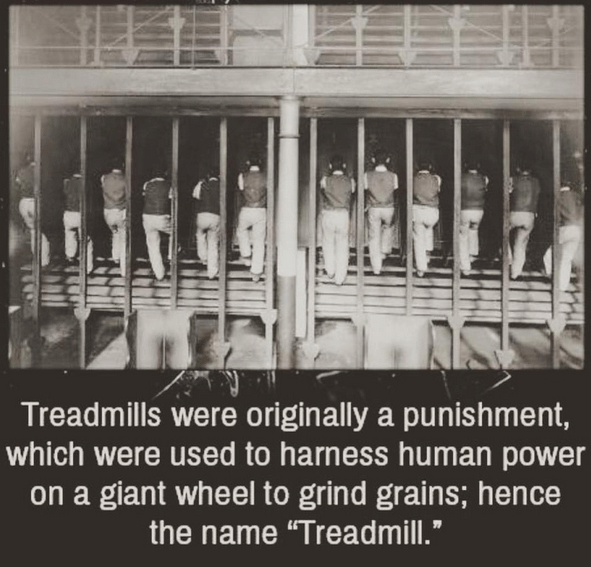The treadmill.
It’s a love hate relationship with the treadmill and triathlon.
You may love them. You may hate them.
You may think they’re a necessary evil to train stronger / faster / longer.
You may not.
This isn’t a post about how you could benefit from the dreadmill, but inspired by an Instagram post I shared of an image and a few subsequent comments as to the possible origin of the treadmill, I thought I’d dive a little further.

THe prison treadmill
Two main questions.
Where did the treadmill originate from?
Why aren’t we using treadmills (or gym bikes etc.,) to harness power?
The history of the treadmill.
Ok, so after a bit of googling and a lot of readin, I think you could write an entire book on the history of the treadmill. I will try to summarise…
The general consensus is that treadmills were developed, pre modern day power, to harness the power of animals or humans to typically grind grain or, going back even earlier (like 4,000+ years ago), they were used to collect water. This form of power evolved to power all sorts of jobs, pre our modern day steam / gas / electric etc. Again, you could write an entire book – but hopefully I covered it off in a VERY succinct way 😉
My focus however, is on humans. One of the ways that people first interacted (by interact I mean powered) with the treadmill was actually as a punishment. I only learnt this from the picture I shared (above). I had no idea, but if you stop and think about it, it makes complete sense in pre-humane times!
According to a few sources I googled, it looks like it was the early 1800’s when they first came into use as a punishment device. Sir William Cubbitt, son of a miller realised the potential of idle prisoners. He thought they could be put their muscle power to good use to grind grain. I didn’t know this either, but apparently Brixton Prison was one of the most infamous mills, gaining notoriety for the punishment that then ensued through using the treadmills! In good old England, we apparently kept this going until sometime in the 19th century, where in the US, they stopped a lot earlier, great you may think… but they put prisoners to use picking cotton, laying bricks, breaking rocks etc. Sounds fun…
So, history shows us that the treadmill was useful, it was painful, it wasn’t really very nice, but it did generate power.
The first “mechanised” treadmill came about in the 1960’s, invented by William Staub, called the Pacemaker 600.
Great, so in a nutshell… that’s where our treadmills came from.
So, why don’t we use them for power today?
Clearly they originated from the requirement of power, then they turned into leisure use. So why aren’t we harnessing the power they may generate? Surely it may help in smaller communities or power gyms themselves to be more economocial?
You could argue that you could just go for a run outside… anyway.
I returned to my friend Google and this is what I found.
The most interesting piece I found on the subject was published by MIT School of Engineering. It actually kind of confirmed my thoughts too. Note, that this was posted in 2011, but I haven’t found any further evidence of increase in power output.
“Addison Killean Stark figures that a robust workout on an elliptical trainer or treadmill that is connected to a device that can convert that output into electricity might deliver 10 Calories per minute, which translates to 700 watts—or the power consumption of seven good light bulbs. While pumping away, an athlete could brightly illuminate a room. A dedicated athlete who commits to an hour on the machine every single day could produce 255 kilowatt hours per year—not a negligible number when the average single-family U.S. home consumes north of 600 kilowatt hours per month.”
The article goes on to suggest that adding on the costs of the running machine, the cost of the converter equipment, the amount of time you’d need to commit to running, the amount of food you’d need to eat to create the energy required to run for 1-4 hours a day… would not way up in the costs department vs what you buy it from the grid. So, lots of work, more cost and not really saving that much!
I turned back to Google.
I clicked a couple of links with articles by national newspaper shining glory on a couple of gyms who are “powered by their own fat” so to speak, and read with interest. Only to then search for those gyms and to see them either not existing any more or that there is 0 mention of their green credentials on their site. Surely, if it was still working, it would be something worthy of shouting about?
The typical treadmill is powered… you would pretty much only be generating enough power to turn that treadmill and make the screen work. You could argue that that itself is power / cost saving.
There are numerous articles about the benefits, as much as there are those against, or rather scientifically saying, what’s the point. Cost vs time does not outweigh the saving. Perhaps if you have a home gym, your effort could power your machine & maybe charge your lights for when you next go out on your night time bike ride.
More googling, more forum reading. So much commentary, whether about treadmills or bikes is that whilst yes, they can create power, you would need to go back to the prison days of chaining people to their bike or treadmill and keep them going pretty much 24/7 to make them actually beneficial in terms of cost savings and for any environmental impact.
I’d love to prove this otherwise. I’d love to build my own personal gym and show that the entire thing could be powered on its own. I don’t believe the “no” answer to this. I just think we maybe haven’t figured it out yet. Or maybe we have, but those websites aren’t very good at SEO!!
Please do share if you have found one!
MIT article here:
https://engineering.mit.edu/ask/could-we-use-exercise-machines-energy-sources

